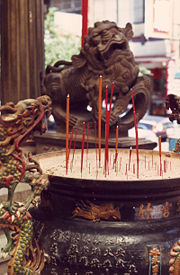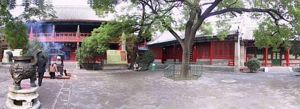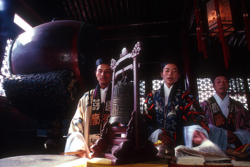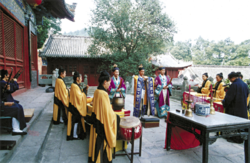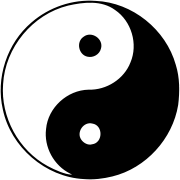Taoism
2008/9 Schools Wikipedia Selection. Related subjects: Philosophy; Religious movements, traditions and organizations
| This article contains Chinese text. Without proper rendering support, you may see question marks, boxes, or other symbols instead of Chinese characters. |
Taoism (pronounced /ˈdaʊ.ɪ.zəm/ or /ˈtaʊ.ɪ.zəm/; also spelled Daoism) refers to a variety of related philosophical and religious traditions and concepts. These traditions have influenced East Asia for over two thousand years and some have spread internationally. The Chinese character Tao 道 (or Dao, depending on the romanisation scheme) means "path" or "way", although in Chinese religion and philosophy it has taken on more abstract meanings. Taoist propriety and ethics emphasize the Three Jewels of the Tao: compassion, moderation, and humility. Taoist thought focuses on wu wei (non-action), spontaneity, transformation and emptiness. An emphasis is placed on the link between people and nature, and that this link lessens the need for rules and order, leading one to a better understanding of the world and one's surroundings.
Nature and ancestor spirits are common in popular Taoism. Organized Taoism distinguishes its ritual activity from that of the folk religion, which some professional Taoists (Daoshi) view as debased. This sort of shamanism is eschewed for an emphasis on internal alchemy among the "elite" Taoists.
Chinese alchemy, astrology, cuisine, several Chinese martial arts, Chinese traditional medicine, fengshui, and many styles of qigong breath training disciplines are intertwined with Taoism throughout history.
Categorization
There is debate over how, and whether, Taoism should be subdivided. Some scholars have divided it into the following three categories:
- "Philosophical Taoism". (Daojia). A philosophical school based on the texts Tao Te Ching and Zhuangzi;
- "Religious Taoism". (Daojiao). A family of organized Chinese religious movements originating from the Celestial Masters movement during the late Han Dynasty and later including the "Orthodox" ( Zhengyi) and "Complete Reality" ( Quanzhen) sects, which trace back to Lao Zi or Zhang Daoling in the late Han Dynasty;
- "Folk Taoism". The Chinese folk religion.
This distinction is complicated by hermeneutic difficulty. The categorization of Taoist sects and movements is very controversial. Many scholars believe that there is no distinction between Daojia and Daojiao. Taoism's start is traced back to Lao-Tzu (or Laozi)
Beliefs
Taoism has never been a unified religion, but has rather consisted of numerous teachings based on various revelations. Therefore, different branches of Taoism often have very distinct beliefs. Nevertheless, there are certain core beliefs that nearly all the schools share.
Principles
Taoism theology emphasizes various themes found in the Tao Te Ching and Zhuangzi, such as naturalness, vitality, peace, "non-action" (wu wei), emptiness (refinement), detachment, the strength of softness (or flexibility), receptiveness, spontaneity, the relativism of human ways of life, ways of speaking and guiding behaviour.
Tao
Tao can be roughly stated to be the flow of the universe, or the force behind the natural order. Tao is believed to be the influence that keeps the universe balanced and ordered. Tao is associated with nature, due to a belief that nature demonstrates the Tao. The flow of qi, as the essential energy of action and existence, is compared to the universal order of Tao. Tao is compared to what it is not, like the negative theology of Western scholars. It is often considered to be the source of both existence and non-existence.
Tao is rarely an object of worship, being treated more like the Indian concepts of atman and dharma. The word "Taoism" is used to translate different Chinese terms. Daojiao/Taochiao (道教 "teachings/religion of the Dao") refers to Daoism as a religion. Daojia/Taochia (道家 "school of the Dao") refers to the studies of scholars, or "philosophical" Taoism. However, most scholars have abandoned the dichotomy of "religious" and "philosophical" Taoism.
De
Tao is also associated with the complex concept of De ( 德) "power; virtue", which is the active expression of Tao. De is the active living, or cultivation, of that "way".
Wu wei
Wu wei ( simplified Chinese: 无为; traditional Chinese: 無為; pinyin: wúwéi) is a central concept in Taoism. The literal meaning of wu wei is "without action". It is often expressed by the paradox wei wu wei, meaning "action without action" or "effortless doing". The practice and efficacy of wu wei are fundamental in Taoist thought, most prominently emphasized in Taoism. The goal of wu wei is alignment with Tao, revealing the soft and invisible power within all things. It is believed by Taoists that masters of wu wei can control this invisible potential, the innate yin-action of the Way.
In ancient Taoist texts, wu wei is associated with water through its yielding nature. Water is soft and weak, but it can move earth and carve stone. Taoist philosophy proposes that the universe works harmoniously according to its own ways. When someone exerts his will against the world, he disrupts that harmony. Taoism does not identify man's will as the root problem. Rather, it asserts that man must place his will in harmony with the natural universe.
Pu
Pu ( simplified Chinese: 朴; traditional Chinese: 樸; pinyin: pǔ, pú; Wade-Giles: p'u; lit. "uncut wood") is translated "uncarved block", "unhewn log", or "simplicity". It is a metaphor for the state of wu wei (無為) and the principle of jian ( 儉). It represents a passive state of receptiveness. Pu is a symbol for a state of pure potential and perception without prejudice. In this state, Taoists believe everything is seen as it is, without preconceptions or illusion.
Pu is seen as keeping oneself in the primordial state of tao. It is believed to be the true nature of the mind, unburdened by knowledge or experiences. In the state of pu, there is no right or wrong, beautiful or ugly. There is only pure experience, or awareness, free from learned labels and definitions. It is this state of being that is the goal of following wu wei.
Spirituality
Taoists believe that human is a microcosm for the universe. The body ties directly into the Chinese five elements. The five organs correlate with the five elements, the five directions and the seasons. Akin to the " hermetic maxim" of "as above, so below", Taoism posits that by understanding himself, man may gain knowledge of the universe, and vice versa.
In Taoism, even beyond Chinese folk religion, various rituals, exercises, and substances are said to positively affect one's physical and mental health. They are also intended to align oneself spiritually with cosmic forces, or enable ecstatic spiritual journeys. These concepts seem basic to Taoism in its elite forms. Internal alchemy and various spiritual practices are used by some Taoists to extend life, theoretically even to the point of immortality.
Ethics
The Three Jewels, or Three Treasures (Chinese: 三寶; pinyin: sānbǎo; Wade-Giles: san-pao), are basic virtues in Taoism. The Three Jewels are compassion, moderation and humility. They are also translated as kindness, simplicity and modesty. Arthur Waley describes them as "[t]he three rules that formed the practical, political side of the author's teaching". He correlated the Three Treasures with "abstention from aggressive war and capital punishment", "absolute simplicity of living", and "refusal to assert active authority".
The first of the Three Jewels is ci (Chinese: 慈; pinyin: cí; Wade-Giles: tz'u; literally "compassion, love, kindness"), which the Tao Te Ching parallels with familial and brotherly love. It is compared to loving others and the world as a person loves their own existence. The second is jian (Chinese: 儉; pinyin: jiǎn; Wade-Giles: chien; literally "moderation, economy, restraint"), which the Tao Te Ching praises. Jian is connected with the Taoist metaphor pu. (樸 "uncarved wood; simplicity"). It represents perfect efficiency and simplicity of desire. The third treasure is the phrase bugan wei tianxia xian (不敢為天下先), meaning "not dare to be first in the world". It is connected to a fear of death, out of a love for life. Taoism posits that to be first is to expose oneself to the world's destructive forces. Remaining behind and embracing humility allows time for one to bear fruit.
Pantheon
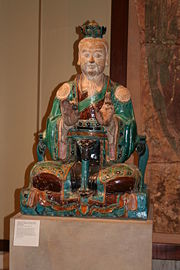
The traditional Chinese religion is polytheistic. Its many deities are part of a heavenly hierarchy that mirrors the bureaucracy of Imperial China. According to their beliefs, Chinese deities may be promoted or demoted for their actions. Some deities are also simply exalted humans, such as Guan Yu, the god of honour and piety. The particular deities worshiped vary according to geographical regions and historical periods in China, though the general pattern of worship is more constant.
There are disagreements regarding the proper composition of this pantheon. Popular Taoism typically presents the Jade Emperor as the official head deity. Intellectual ("elite") Taoists, such as the Celestial Masters sect, usually present Laozi (Laojun, "Lord Lao") and the Three Pure Ones at the top of the pantheon of deities.
While a number of immortals or other mysterious figures appear in the Zhuangzi, and to a lesser extent in the Tao Te Ching, these have generally not become the objects of worship. Traditional conceptions of Tao are not to be confused with the Western concepts of theism and monotheism. Being one with the Tao does not indicate a union with an eternal spirit in the Hindu sense, but rather living in accordance with nature.
Scripture
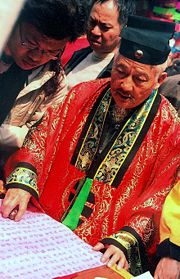
Tao Te Ching
The Tao Te Ching, or Daodejing, is widely considered to be the most influential Taoist text. It is a foundational scripture of central importance in Taoism. It has been used as a ritual text throughout the history of religious Taoism. However, the precise date that it was written is the subject of debate: there are those who put it anywhere from the 6th century BC to the 3rd century BC.
Taoist commentators have deeply considered the opening lines of the Tao Te Ching. They are widely discussed in both academic and mainstream literature. A common interpretation is similar to Korzybski's observation that " the map is not the territory". The opening lines, with literal and common translation, are:
道可道,非常道。 (Tao (way or path) can be said, not usual way)
"The Way that can be described is not the true Way."
名可名,非常名。 (names can be named, not usual names)
"The Name that can be named is not the constant Name."
Tao literally means "path" or "way"(and also means "say" or "be said"), and can figuratively mean "essential nature", "destiny", "principle", or "true path". The philosophical and religious "Tao" is infinite, without limitation. One view states that the paradoxical opening is intended to prepare the reader for teachings about the unteachable Tao. Tao is believed to be transcendent, indistinct and without form. Hence, it cannot be named or categorized. Even the word "Tao" can be considered a dangerous temptation to make Tao a limiting "name".
The Tao Te Ching is not thematically ordered. However, the main themes of the text are repeatedly expressed using variant formulations, often with only a slight difference. The leading themes revolve around the nature of Tao and how to attain it. Tao is said to be unnameable and accomplishing great things through small means. There is significant debate regarding which English translation of the Tao Te Ching is preferred, and which particular translation methodology is best. Discussions and disputes about various translations of the Tao Te Ching can become acrimonious, involving deeply entrenched views.
Ancient commentaries on the Tao Te Ching are important texts in their own right. The Heshang Gong commentary was most likely written in the second century AD, and as perhaps the oldest commentary, contains the edition of the Tao Te Ching that was transmitted to the present day. Other important commentaries include the Xiang'er, one of the most important texts from the Celestial Master movement, and Wang Bi's commentary.
Daozang
The Daozang (道藏, Treasury of Tao) is sometimes referred to as the Taoist canon. It was originally compiled during the Jin, Tang, and Song dynasties. The version surviving today was published during the Ming dynasty. The Ming Daozang includes almost 1500 texts. Following the example of the Buddhist Tripitaka, it is divided into three dong (洞, "caves", "grottoes"). They are arranged from "highest" to "lowest":
- The Zhen ("real" or "truth"真) grotto. Includes the Shangqing texts.
- The Xuan ("mystery"玄) grotto. Includes the Lingbao scriptures.
- The Shen ("divine"神) grotto. Includes texts predating the Maoshan (茅山)revelations.
Daoshi generally do not consult published versions of the Daozang, but individually choose, or inherit, texts included in the Daozang. These texts have been passed down for generations from teacher to student.
The Shangqing school has a tradition of approaching Taoism through scriptural study. It is believed that reciting certain texts often enough will be rewarded with immortality. In Taiwan, one often finds Buddhist texts being chanted in Taoist temples.
Other texts
While the Tao Te Ching is most famous, there are other important texts in traditional Taoism. Taishang Ganying Pian ("Treatise of the Exalted One on Response and Retribution") discusses sin and ethics, and has become a popular morality tract in the last few centuries. It asserts that those in harmony with Tao will live long and fruitful lives. The wicked, and their descendents, will suffer and have shortened lives. Both the Taipingjing ("Scripture on Great Peace") and the Baopuzi ("Book of the Master Who Keeps to Simplicity") contain early alchemical formulas that early Taoists believed could lead to immortality. A book titled "The Wisdom Of Laotse" offers a translation of "The Book of Tao" while comparing Laotse's philosophies against Kǒng Fūzǐ's (Confucius)
Zhuangzi
The Zhuangzi (莊子) was named after its author, who also appears as a character in the book's narrative. It is more in the form of a collection of stories than the short aphorisms and maxims of the Tao Te Ching. Also among the cast of characters in the Zhuangzi's stories is Laozi of the Tao Te Ching, as well as Confucius.
History
Taoism's origins may be traced to prehistoric Chinese religions in China. They are found in the composition of the Tao Te Ching ( 3rd or 4th century BC). Laozi received imperial recognition as a divinity in the mid second century AD., Several Song emperors, most notably Huizong, were active in promoting Taoism, collecting Taoist texts and publishing editions of the Daozang. Aspects of Confucianism, Taoism, and Buddhism were consciously synthesized in the Neo-Confucian school, which eventually became Imperial orthodoxy for state bureaucratic purposes. During the eighteenth century, the imperial library was constituted, but excluded virtually all Taoist books. By the beginning of the twentieth century, Taoism had fallen so much from favour, that only one complete copy of the Daozangstill remained, at the White Cloud Monastery in Beijing. Taoism is one of five religions recognised by the PRC, which insists on controlling its activities through a state bureaucracy (the China Taoist Association).
Adherents
The number of Taoists is difficult to estimate, partly for definitional reasons (who counts as a Taoist?), and partly for practical ones (it is illegal for private parties to conduct surveys in China). The number of people practicing some aspect of the Chinese folk religion might number in the hundreds of millions. ( Adherents.com estimates "Traditional Chinese religion" at nearly four hundred million). The number of people patronising Daoshi (Taoist priests or masters) would be smaller by several orders of magnitude, while the number of literary Daojia would be smaller yet. At the same time, most Chinese people and many others have been influenced in some way by Taoist tradition. Most estimates for the amount of Taoists (either worldwide or simply outside of mainland China) are 20–30 million.
Geographically, Taoism flourishes best in regions populated by Chinese people: mainland China, Taiwan, Malaysia, Singapore, and various Chinese diaspora communities. Taoist literature and art has influenced the cultures of Korea, Japan and Vietnam, and these countries' folk religions have many common elements. Organized Taoism seems not to have attracted a non-Chinese following until modern times. In Taiwan, 4.5–7.5 million people (33% of the population) are Taoists. In Singapore, 8.5% of the population is Taoist. There are also small numbers of Taoists in the Western world, and Japan, Vietnam and Korea are culturally influenced by Taoism even though the organized religion has mostly died out.
Practices

At certain dates, food may be set out as a sacrifice to the gods and/or spirits of the departed. (See, for example, Qingming Festival.) This may include slaughtered pigs and ducks, or fruit. Another form of sacrifice involves the burning of Joss paper or Hell Bank Notes, on the assumption that images thus consumed by the fire will reappear—not as a mere image, but as the actual item—in the spirit world, and be available for the departed spirit to use.
Secular Activities
Also at certain dates, street parades take place. These are lively affairs which invariably involve firecrackers and flower-covered floats broadcasting traditional music. Street parades may also include lion dances and dragon dances; human-occupied puppets (often of the "Seventh Lord" and "Eighth Lord"); jitong (乩童 male "Mediums") who mutilate their skin with knives; Bajiajiang, which are gongfu-practicing honour guards in demonic makeup; and palanquins carrying god-images. The various participants are not considered performers, but rather possessed by the god in question.
Fortune-telling—including astrology, I Ching, and other forms of divination—has long been considered a traditional Taoist pursuit. Mediumship is also widely encountered. We may distinguish between martial forms of mediumship (like the aforementioned jitong) and X spirit-writing, typically through the practice of fuji (planchette writing).
Many Taoists also participated in the reading and writing of books. Taoists of this type tend to be civil servants, elderly retirees, or in modern times, university faculty. While there is considerable overlap with religious Taoism, there are often important divergences in interpretation. Wang Bi, one of the most influential philosophical commentators on the Laozi (and Yijing) was in fact a Confucian.
For many educated Chinese people (the Literati), life was divided into a social aspect, where Confucian doctrine prevailed, and a private aspect, with Taoist aspirations. Night-time, exile, or retirement provided the opportunity to cultivate Taoism and reread Laozi and Zhuangzi. The Literati often dedicated this period of life to arts such as calligraphy, painting, and poetry, or personal researches into antiquities, medicine, folklore, and so on.
A number of martial arts traditions, particularly T'ai Chi Ch'uan, Bagua Zhang, Won Yuen Yat Hey Jueng, Bak Mei Pai, Bok Fou Pai, Yaw Gong Moon and Xing Yi Quan, embody Taoist principles to a greater or lesser extent, and some practitioners consider their art to be a means of practicing Taoism. The accuracy of these claims varies greatly depending on the particular art and/or practitioner.
It should be noted that while many Japanese and Korean martial and cultural traditions (i.e. judo, kendo, cha-do, kyu-do, shinto, Hapkido, Taekwondo, Tangsudo) have developed a distinctly zen character over the years, the "do" or "to" is in fact one of the Japanese / Korean pronunciations of the Chinese "tao" (alternatedly rendered as "dao" by some translators), and it is written with the same character. Again, the extent to which these practices reflect taoist principles varies depending on the specific school and practitioner.
Taoist symbols and images
There are many symbols and images that are associated with Taoism. Like the " cross" in Christianity, and the " wheel" in Buddhism, Taoism has Laozi, actual Chinese characters, and many other symbols that are often represented or associated with it.
The Taijitu (" yin and yang") symbol 太極圖 as well as the Bagua 八卦 ("Eight Trigrams") are associated with Taoist symbolism. While almost all Taoist organizations make use of the yin and yang symbol, one could also call it Confucian, Neo-Confucian or pan-Chinese. The yin and yang make a backwards "S" shape, with yin (black or red) on bottom. One is likely to see this symbol as decorations on Taoist organization flags and logos, temple floors, or stitched into clerical robes. According to Song Dynasty sources, it originated around the 10th century. Previously, yin and yang were symbolized by a tiger and dragon. (This is one of the places where the surface Dao and the hidden dao is shown. On the surface the picture of the Dao with a Tiger and a dragon is no more than just a picture. But beneath is the one of the way to immortality called "The White Tigress and The Jade Dragon" and it is the pure Female-male energy.)
The two major way that are used today are white on top / black at bottom or reverse black on top / white at the bottom. White on top is called Early Heaven and symbolize going back to the basic or keeping the mind and the body young like a child. When it is black on top, it is called Later Heaven and is the way the world normally moves and normally means going to the grave.
The five directions as conceived by the ancient Chinese (east, south, west, north, centre) each have their own attributes, as follows in the chart below.
| Direction | Element / Phase | / Symbol | Season | Force |
| East | Wood | Azure Dragon | Spring | Yang |
| South | Fire | Vermilion Bird | Summer | Yang |
| West | Metal | White Tiger | Autumn | Yin |
| North | Water | Black Tortoise | Winter | Yin |
| Centre | Earth | Yellow Dragon | Changing of the seasons | Yin/Yang balance |
Taoist temples may fly square or triangular flags. They typically feature mystical writing or diagrams and are intended to fulfill various functions including providing guidance for the spirits of the dead, to bring good fortune, increase life span, etc. Other flags and banners may be those of the gods or immortals themselves.
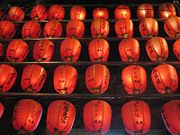
One sometimes sees a zigzag with seven stars, representing the Big Dipper (or the "Bushel", the Chinese equivalent). In the Shang dynasty the Big Dipper was considered a deity, while during the Han dynasty, it was considered a qi path of the circumpolar god, Taiyi.
Taoist temples in southern China and Taiwan may often be identified by their roofs, which feature Chinese dragons and phoenixes made from multi-colored ceramic tiles. They also stand for the harmony of yin and yang (with the phoenix being yin). A related symbol is the flaming pearl which may be seen on such roofs between two dragons, as well as on the hairpin of a Celestial Master. But in general, Chinese Taoist architecture has no universal features that distinguish it particularly from other structures.
Relations with other religions and philosophies

The origins of Taoism and other philosophical schools are intimately related. The authorship of the Daodejing is assigned to Laozi, traditionally thought to be a teacher of Confucius, yet appears to be reacting against Confucian doctrine (suggesting the text comes after Confucianism). Zhuangzi (Chuang Tzu), the other defining philosopher of Taoism, reacted both to the Confucian-Mohist ethical disputes and to related developments in theory of names (language). There is little evidence of a link between Laozi and Zhuangzi—whose most frequent interactions are with Hui Shi (of the school of names). However, the chapters of the Zhuangzi written after his death include dialogues between Laozi and Confucius that mimic (or inspire?) the style of the Daodejing, suggesting the first association of the two texts dates from around that time. The "history of thought" contained in the Zhuangzi cites Laozi as a prior step (and demotes Hui Shi to a postscript). It includes the Mohists by name and the Confucians by implication and a cluster of other less well known thinkers.
These early Taoist texts reject numerous basic assumptions of Confucianism, embracing instead values based on nature, perspectivalism, and spontaneity. They express skepticism of conventional moralities and Mozi's Utilitarian or Mencius' benevolence based revisions. Since politics was conceived by these traditional schools as a scheme for unifying all "under the sky" in their favored dao, Taoists tend toward anarchism, mistrustful of hierarchical social structures and particularly, governments. (Zhuangzi argues that the proponents of benevolence and morality are usually found at the gates of feudal lords who have stolen their kingdoms.)
Taoist thought partly inspired Legalist philosophers, whose theories were used by Qin Shi Huang, founder of the Chinese Empire. The junction point can be found in the work of Hanfeizi, a prominent Legalist thinker who commented on the Tao Te Ching. Hanfeizi used some chapters of the book to justify a structured society based on law and punishment and on the undiscussed power of the Emperor.
The entry of Buddhism into China was via its dialectic with later Taoism which transformed them both. Over the centuries of Chinese interactions, Buddhism gradually found itself transformed from a competitor of Taoism, to a fellow inhabitant of the Chinese cultural ecosystem. Originally seen as a kind of foreign Taoism, its scriptures were translated into Chinese with Taoist vocabulary. Chan Buddhism in particular is inspired by crucial elements of philosophical Taoism, ranging from distrust of scripture, text and language to its more positive view of "this life", practice, skill and the absorption in "every-moment". In the Tang period some Taoist schools incorporated such Buddhist elements as monasteries, vegetarianism, prohibition of alcohol, the celibacy of the clergy, the doctrine of emptiness, and the amassing of a vast collection of scripture into tripartite organisation. However, there are some who argue that Taoism had vegetarianism first. Some Buddhist schools incorporated it later. Also during Tang Dynasty, some Taoist practices and books spread to Tibet and became incorporated in Tibetan Buddhism.
Ideological and political rivals in ancient times, Taoism, Confucianism, and Buddhism have inevitably deeply influenced one another, and eventually achieved a kind of modus vivendi in which each has its own particular ecological niche within Chinese society. With time, most Chinese people likewise came to identify to some extent with all three traditions simultaneously. This became institutionalised by the time of the Song Dynasty, when aspects of the three schools were consciously synthesised in the Neo-Confucian school, which eventually became Imperial orthodoxy for state bureaucratic purposes.
The Vinegar Tasters (sometimes called Three Vinegar Tasters) is a popular painting (usually in scroll format) that explained Taoist ideals in relation to the Neo-Confucian school which began in the 10th century and gained prominence in the 12th century. The image depicts Laozi together with The Buddha, and Confucius. In these paintings the three are gathered around a vat of vinegar and the motto associated with the grouping is "the three teachings are one." (However, see The Vinegar Tasters for an alternate interpretation.)
Taoism does not fall strictly under an umbrella or a definition of an organized religion like the Abrahamic traditions, nor could it be studied as the originator or variants of Chinese folk religion, for the simple reason that these were not the tenets or core teachings of Taoism or those in Tao te Ching. Robinet further asserted that the nature of Taoism can be better understood as a psyche, and a way of life rather than a religion, as the adherents do not view Taoism in the manner analysed by historians who were neither Taoist and who did not understand the subject.
Many scholarly works conclude that Taoism is a school of thought with a quest for Immortality. Viewed in this light,Taoism is dissimilar to most other religions who, though they may involve immortality of the soul such as in Hinduism where one's soul joins Brahman, or the spiritual immortality of an Enlightened Buddhist, but physical immortality is present only in Taoism and Christianity. In the latter, when God resurrects the dead, everyone judged to have had faith will live eternally.
Tao in the West
The west has recently embraced aspects of Taoism: the name and concept of Tao, the names and concepts of yin and yang; an appreciation for Laozi and Zhuangzi, and a respect for other aspects of Chinese tradition such as qigong. At the same time, Western appropriations differ in subtle (or not so subtle) ways from their Asian sources. For example, the word Tao is used in numerous book titles which are connected to Chinese culture only tangentially. Examples would include Fritjof Capra's The Tao of Physics, or Benjamin Hoff's The Tao of Pooh. These uses of Tao are more as a token of exoticism or esotericness (similar to "The Zen of...") rather than referring to Taoism itself.
Taoism has also been a resource for those in environmental philosophy, who see the non-anthropocentric nature of Taoism as a guide for new ways of thinking about nature and environmental ethics. Some consider Taoism to fit naturally with the radical environmental philosophy of deep ecology. Taoism and Ecology: Ways Within A Cosmic Landscape edited by N. J. Girardot, James Miller, and Liu Xiaogan is currently the most thorough introduction to studies done on concepts of nature and ecology within Taoism.
